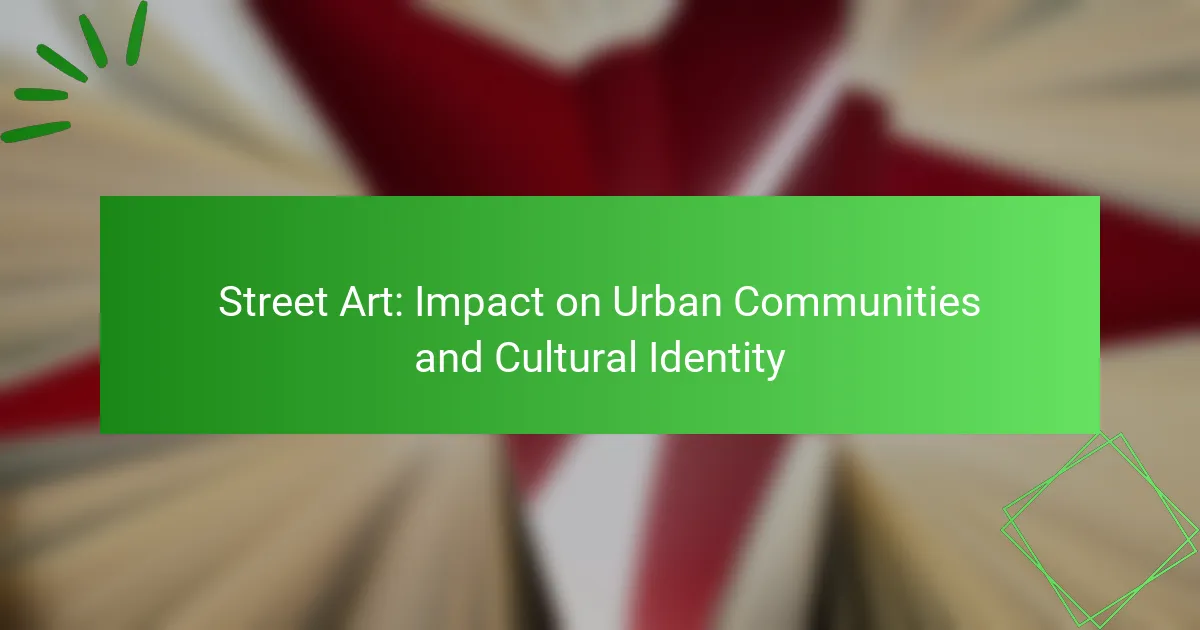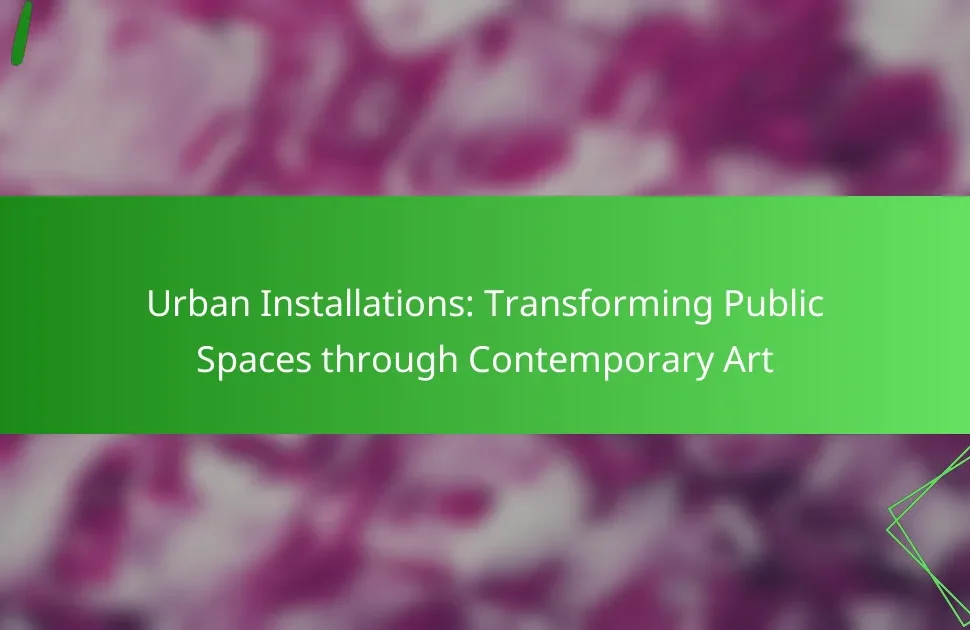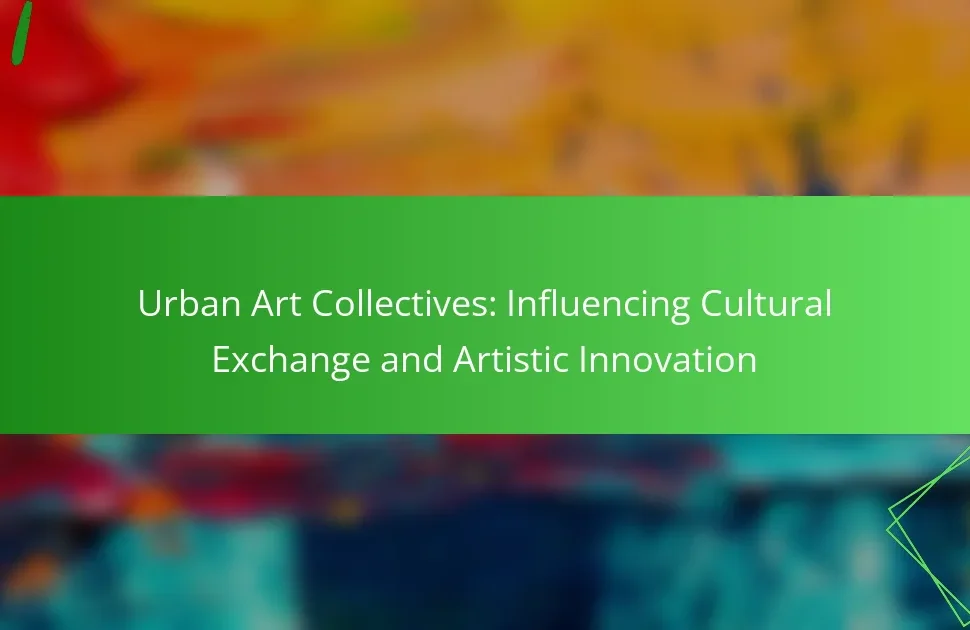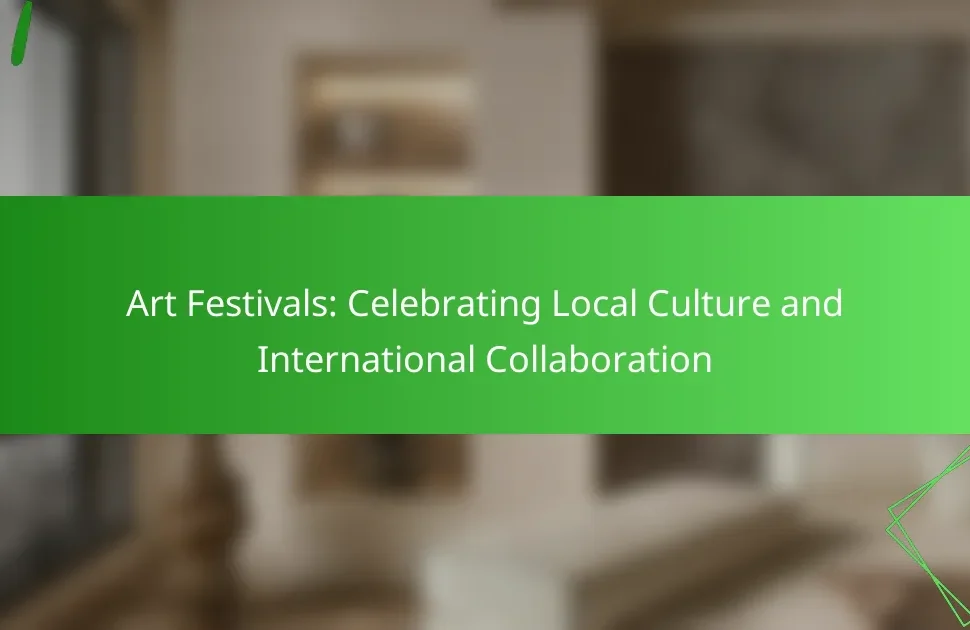Street art significantly impacts urban communities by enhancing cultural identity and fostering community engagement. It reflects local values and social issues, creating a sense of belonging. Additionally, street art attracts tourism and boosts local economies while serving as a platform for activism. This article explores how street art shapes community identity, encourages participation, and navigates legal considerations in urban environments.
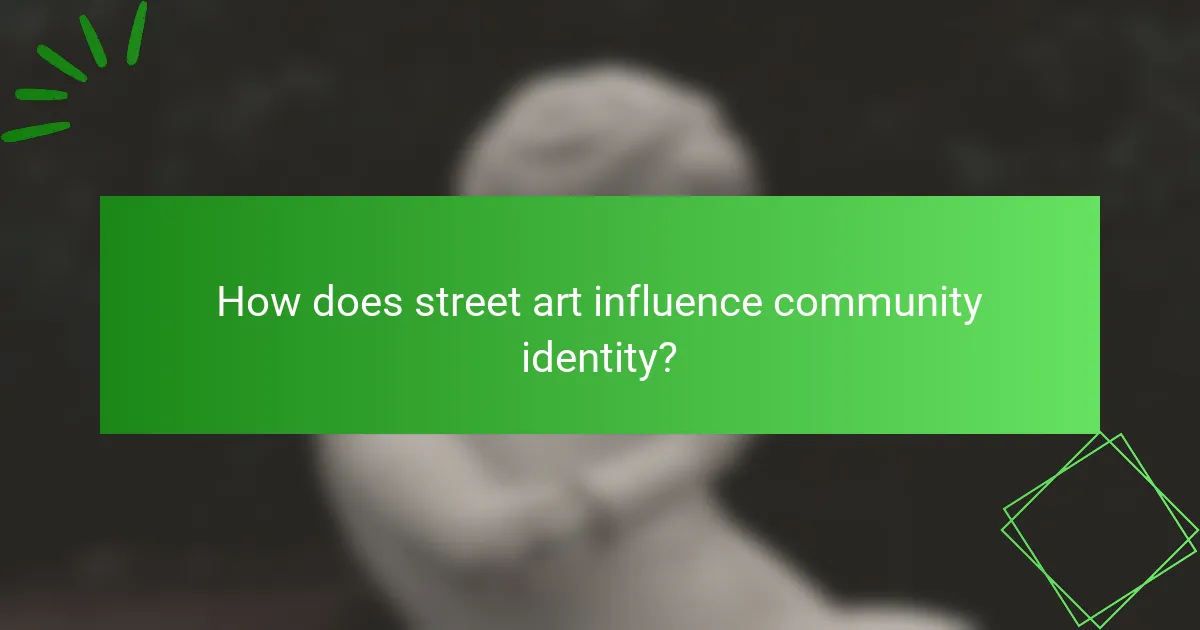
How does street art influence community identity?
Street art significantly shapes community identity by fostering cultural expression and enhancing public spaces. It reflects local values, history, and social issues, creating a sense of belonging.
Street art encourages community engagement, as residents often collaborate on murals or installations. This participation strengthens social bonds and promotes pride in neighborhood identity.
Moreover, street art can attract tourism, bringing economic benefits. Cities known for vibrant street art scenes often see increased foot traffic, supporting local businesses.
Finally, the unique styles of street artists contribute to a community’s distinct character. Each artist’s individual expression adds layers to the collective identity, making the area more recognizable.
What role does street art play in cultural expression?
Street art plays a vital role in cultural expression by reflecting community identity and social issues. It serves as a voice for marginalized groups, allowing them to convey messages that might be overlooked in mainstream media. Additionally, street art can transform urban spaces, fostering a sense of belonging and pride among residents. The unique attributes of street art, such as its accessibility and spontaneity, enable it to engage a diverse audience. As a result, it often sparks dialogue and encourages cultural exchange within urban environments.
How do local communities engage with street artists?
Local communities engage with street artists through collaboration, support, and cultural exchange. Artists often work with local organizations to create murals that reflect community identity. These collaborations can foster pride and encourage dialogue among residents. Community events, such as festivals, allow artists to showcase their work and interact with the public. This engagement enhances cultural vibrancy and promotes a sense of belonging. Additionally, local businesses may sponsor street art projects, further integrating art into the community’s fabric.
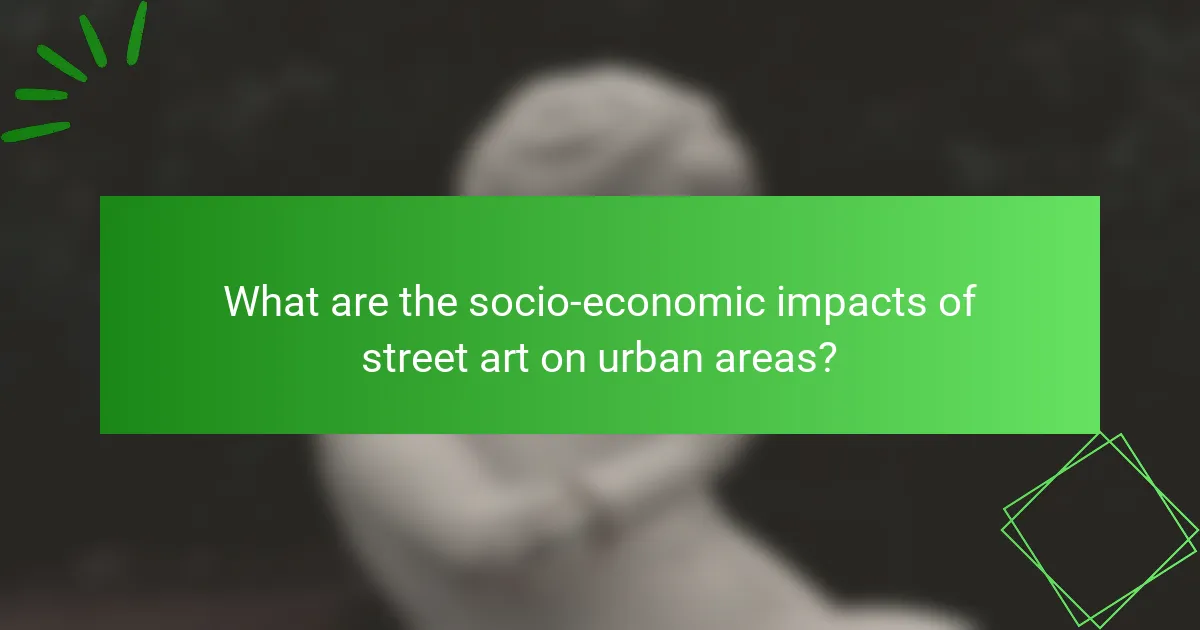
What are the socio-economic impacts of street art on urban areas?
Street art positively impacts urban areas by enhancing cultural identity, boosting local economies, and fostering community engagement. It attracts tourism and revitalizes neglected spaces. Studies show that neighborhoods with vibrant street art experience increased foot traffic and higher property values. Additionally, street art serves as a platform for social commentary, addressing local issues and promoting dialogue. This unique attribute of street art enriches the urban landscape, making it a catalyst for socio-economic development.
How does street art contribute to local economies?
Street art significantly boosts local economies by attracting tourism, enhancing property values, and fostering community engagement.
Art installations draw visitors, increasing foot traffic to nearby businesses. For instance, cities like Berlin and Melbourne report economic growth linked to vibrant street art scenes.
Additionally, street art revitalizes neglected areas, making them more appealing for investment. This improvement can lead to higher property values and increased tax revenue.
Moreover, local artists often collaborate with businesses, creating a unique cultural identity that differentiates neighborhoods. This collaboration strengthens community ties and promotes local pride.
What challenges do street artists face in urban environments?
Street artists face significant challenges in urban environments, including legal restrictions, public perception, and safety concerns. Legal issues arise from the lack of permits, leading to fines or removal of artwork. Public perception can vary, with some viewing street art as vandalism rather than legitimate expression. Safety concerns include the risk of injury while working in urban settings, particularly in high-traffic areas. Additionally, gentrification often displaces artists, limiting their creative spaces and opportunities. These factors collectively impact the sustainability of street art in urban communities.
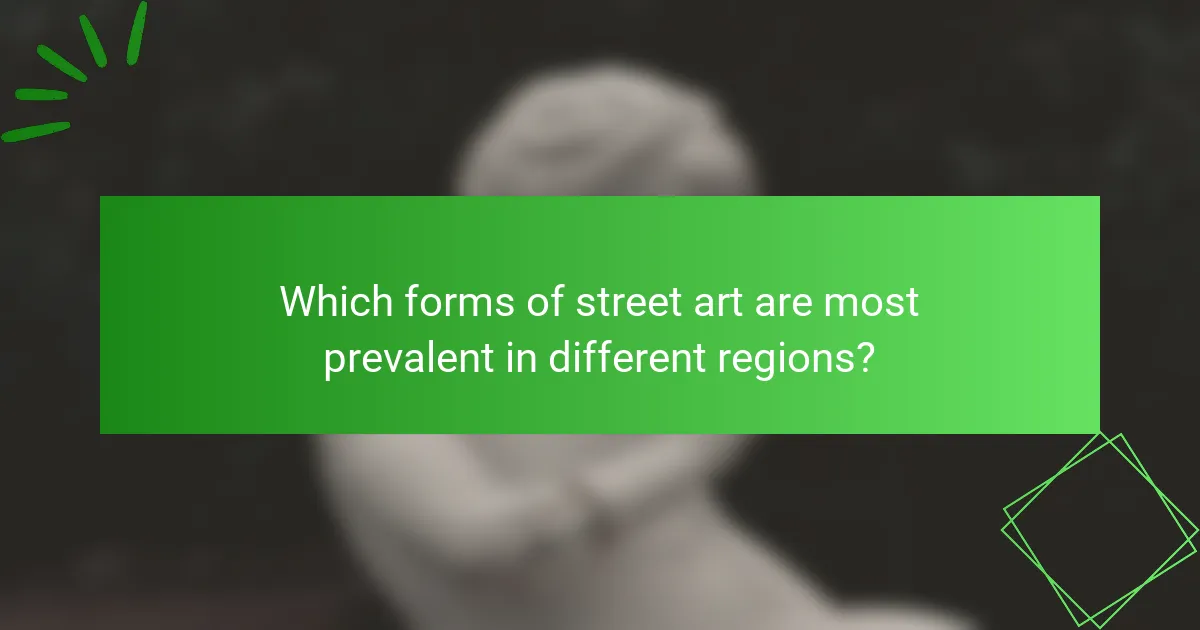
Which forms of street art are most prevalent in different regions?
Street art varies significantly across regions, reflecting local cultures and issues. In Europe, murals and graffiti often address social and political themes. In Latin America, vibrant colors and folk influences dominate, showcasing cultural heritage. North America features diverse styles, including stencil art and street installations, often emphasizing urban identity. Asian street art frequently combines traditional motifs with contemporary techniques, creating unique visual narratives. Africa showcases community-driven projects that promote social change and local pride. Each region’s street art serves as a mirror of its cultural identity and urban challenges.
How do styles of street art vary across cultures?
Street art styles vary significantly across cultures, reflecting local identities and social issues. In Europe, street art often incorporates political themes, while in Latin America, vibrant colors and cultural symbols dominate. Asian street art frequently blends traditional motifs with modern techniques. The unique attributes of each culture shape the messages conveyed through the art, creating a rich tapestry of urban expression. For instance, in the United States, graffiti has roots in hip-hop culture, emphasizing community and resistance. These variations highlight how street art serves as a mirror to societal values and histories.
What unique techniques are used by street artists globally?
Street artists globally employ techniques such as stenciling, mural painting, and wheatpasting to convey messages and enhance urban spaces. Stenciling allows for rapid execution and intricate designs, as seen in the works of Banksy. Mural painting transforms large surfaces into engaging narratives, fostering community pride. Wheatpasting, which involves adhering printed materials to walls, is often used for political statements. These methods not only beautify neighborhoods but also reflect cultural identities and social issues.
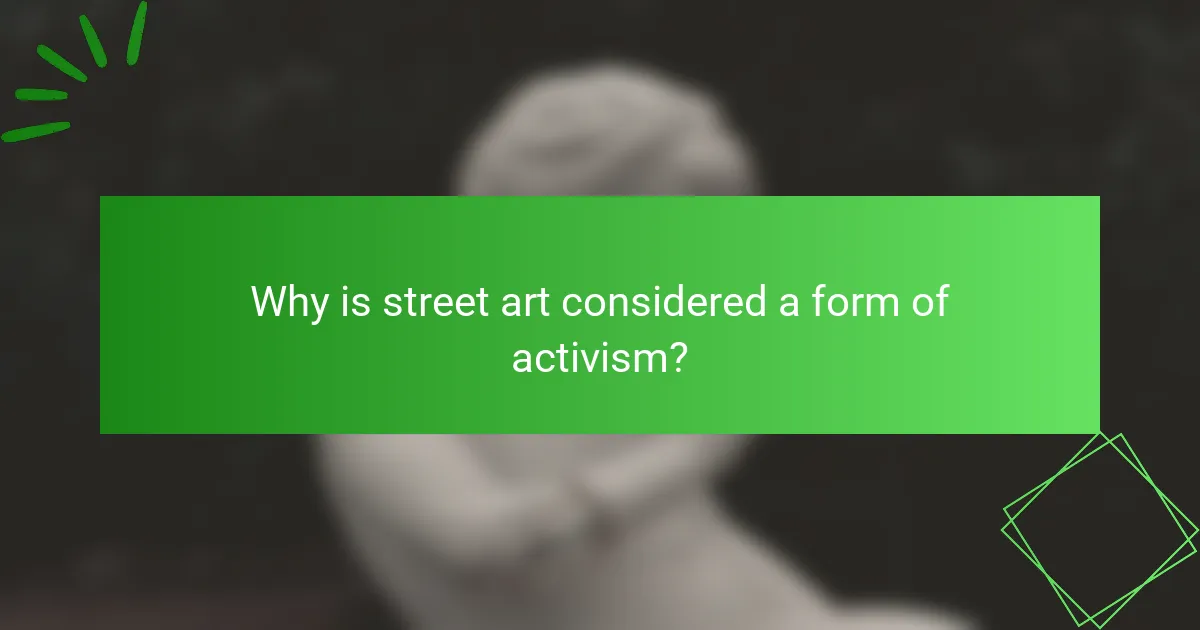
Why is street art considered a form of activism?
Street art is considered a form of activism because it challenges social norms and raises awareness on critical issues. Artists use public spaces to convey messages about inequality, environmental concerns, and political dissent. This expression fosters community engagement and cultural identity. Street art often acts as a visual dialogue, prompting conversations that can lead to social change. For instance, murals can reflect local struggles and triumphs, making art a powerful tool for activism.
How do street artists address social issues through their work?
Street artists address social issues by using their work to provoke thought, inspire dialogue, and promote awareness. They often tackle themes such as inequality, racism, and environmental concerns through powerful visuals.
For example, murals depicting social justice movements can galvanize communities and encourage activism. These artworks serve as a voice for marginalized groups, giving them representation in urban spaces.
Additionally, street art can transform neglected areas into vibrant cultural hubs, fostering community pride and identity. By engaging with local residents, artists can create pieces that resonate with their experiences and challenges.
Overall, street art not only beautifies urban landscapes but also catalyzes social change and reinforces cultural narratives.
Which notable street art movements have emerged recently?
Recent notable street art movements include social activism, muralism, and digital street art. These movements have reshaped urban landscapes and cultural identities. Social activism in street art highlights issues like racial justice and climate change, fostering community engagement. Muralism revitalizes neighborhoods, enhancing public spaces and local pride. Digital street art incorporates technology, allowing artists to reach wider audiences through social media and augmented reality. Each movement reflects a unique attribute of contemporary urban culture, emphasizing the power of art in societal change.
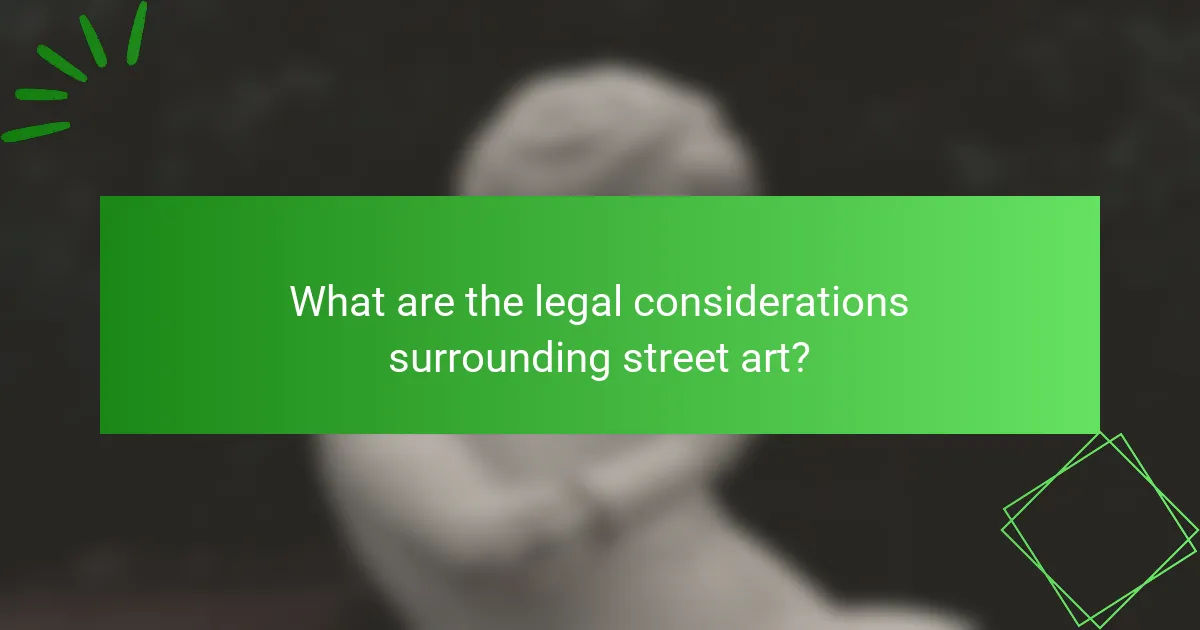
What are the legal considerations surrounding street art?
Street art often exists in a legal gray area, raising various considerations. Artists may face issues of copyright, vandalism, and property rights. Local laws vary widely, impacting the legality of street art in urban environments. For example, some cities have designated spaces for legal murals, while others strictly prohibit unauthorized art. Understanding these legal frameworks is crucial for artists and communities to navigate the implications of street art on cultural identity and urban transformation.
How do laws differ regarding street art in urban settings?
Laws regarding street art vary significantly across urban settings, reflecting local cultural values and governance. In some cities, street art is embraced, often protected as a form of public expression. For example, cities like Berlin have established legal frameworks that support artists. Conversely, in places like New York, strict anti-graffiti laws can lead to arrests and fines for unauthorized works. The legal status of street art influences its role in community identity and cultural dialogue, making it a vital aspect of urban development.
What are the implications of graffiti as street art?
Graffiti as street art significantly influences urban communities and cultural identity. It fosters local pride, encourages dialogue, and can lead to economic revitalization.
Street art often reflects the community’s voice, addressing social issues and cultural narratives. For instance, murals can commemorate historical events or highlight local struggles, creating a sense of belonging among residents.
Additionally, street art can attract tourism, leading to increased foot traffic and business opportunities. Cities like Berlin and Melbourne have become renowned for their vibrant street art scenes, demonstrating how these artworks can enhance cultural identity and community engagement.
However, the implications can be complex. While some view graffiti as a form of artistic expression, others perceive it as vandalism. This duality can lead to debates about public space usage and urban aesthetics.
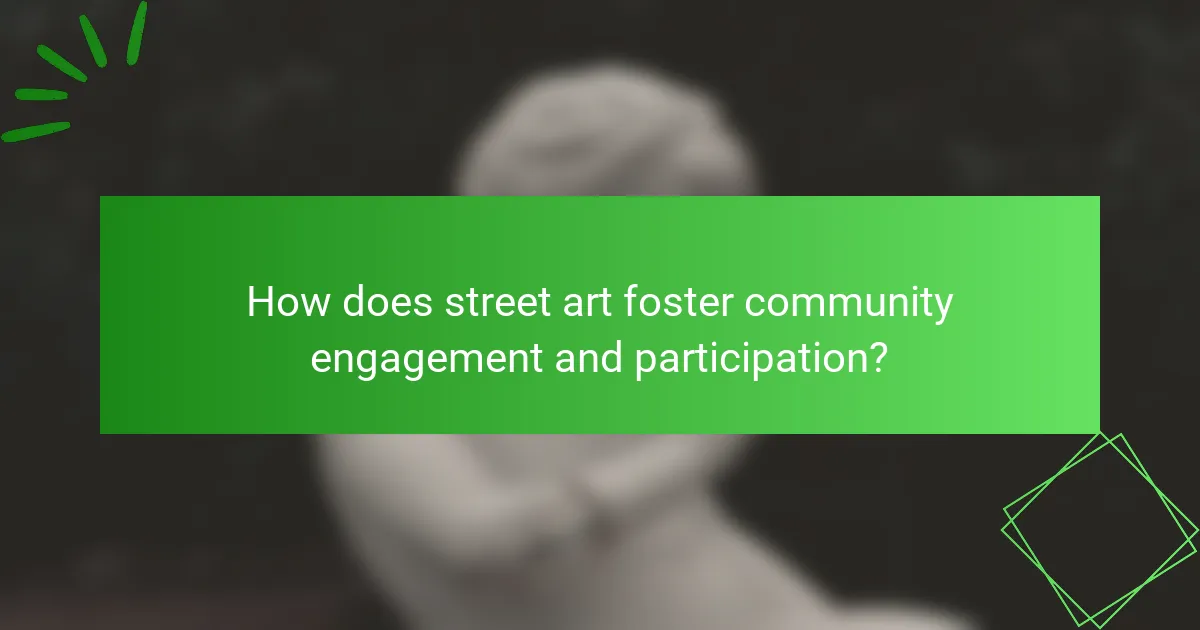
How does street art foster community engagement and participation?
Street art fosters community engagement and participation by creating shared spaces for expression and dialogue. It transforms public areas into platforms for local voices, enhancing cultural identity. Collaborative projects encourage residents to contribute, fostering a sense of ownership. Furthermore, street art often addresses social issues, sparking conversations that unite diverse community members.
What initiatives promote collaboration between artists and residents?
Collaborative initiatives between artists and residents enhance community engagement and cultural identity. Programs like mural projects, community art workshops, and public art installations foster dialogue and participation. These initiatives often focus on local themes, allowing residents to contribute their stories and perspectives. As a result, urban spaces transform into vibrant canvases that reflect the community’s diversity and creativity.
How do public events and festivals celebrate street art?
Public events and festivals celebrate street art by showcasing local talent and fostering community engagement. These events transform urban spaces into vibrant galleries, allowing artists to display their work and connect with audiences.
Street art festivals often include live mural painting, workshops, and artist talks, enhancing cultural identity. They attract tourists, boosting local economies while promoting appreciation for urban art forms.
Such celebrations can highlight unique attributes of street art, like its ephemeral nature and ability to address social issues. By involving diverse communities, these events create a shared cultural experience that strengthens local identity and pride.
As a result, public events and festivals serve as vital platforms for street artists, ensuring their contributions to urban culture are recognized and celebrated.
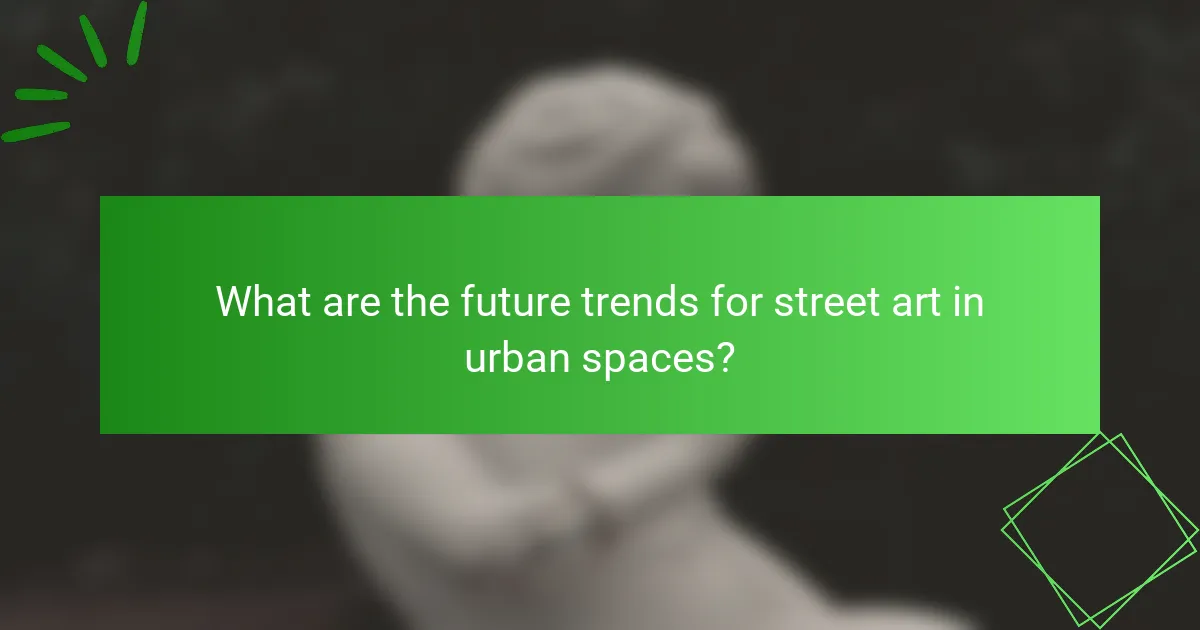
What are the future trends for street art in urban spaces?
Street art will increasingly shape urban communities through technology, sustainability, and social engagement. Artists will leverage augmented reality to enhance interactions with their work. Eco-friendly materials will gain prominence, reflecting community values. Collaborative projects will foster cultural identity and inclusivity, making art a tool for dialogue. Cities may designate more public spaces for street art, acknowledging its role in urban revitalization and tourism.
How is technology shaping the evolution of street art?
Technology is significantly shaping street art by enhancing visibility and accessibility. Digital platforms allow artists to share their work globally, fostering community engagement and cultural exchange. Augmented reality apps enable interactive experiences, deepening audience connection to the art. Furthermore, social media amplifies the reach of street artists, transforming local expressions into global movements. As a result, technology not only preserves cultural identity but also encourages urban communities to celebrate diversity through street art.
What predictions can be made for the role of street art in culture?
Street art will increasingly shape urban culture by fostering community engagement and identity. It serves as a visual narrative, reflecting local histories and social issues. As cities evolve, street art can enhance public spaces, promote tourism, and stimulate economic growth. Artists will likely collaborate with local governments to create inclusive projects that resonate with diverse populations. This evolving role will solidify street art’s position as a vital cultural component in urban environments.
What best practices can communities adopt to support street art?
Communities can adopt several best practices to support street art, enhancing urban culture and identity.
1. Establish designated spaces for street art to encourage creativity and reduce vandalism.
2. Collaborate with local artists to create murals that reflect community values and history.
3. Organize events and festivals that celebrate street art, fostering community engagement.
4. Implement educational programs in schools to teach the value of street art as a form of expression.
5. Involve local businesses in supporting street art initiatives through sponsorship or partnership.
6. Promote maintenance and preservation of existing artworks to sustain cultural heritage.
